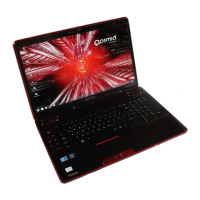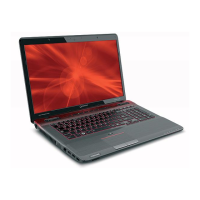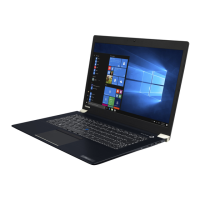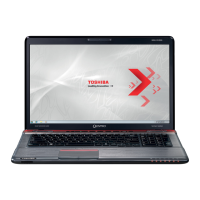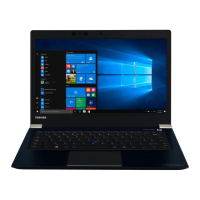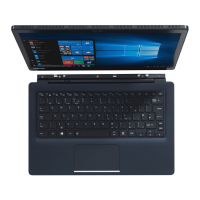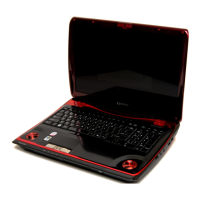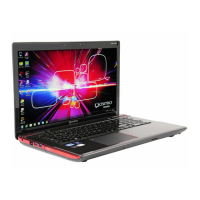
Do you have a question about the Toshiba X870 and is the answer not in the manual?
| Display | 17.3-inch |
|---|---|
| Battery | 6-cell Lithium-ion |
| Processor | Intel Core i7-3610QM |
| Graphics | NVIDIA GeForce GTX 670M |
| Operating System | Windows 7 Home Premium |
Information on copyright, disclaimers, and trademarks for the manual and computer.
Provides legal and regulatory compliance info, including FCC and other standards.
Specifies approved/unapproved environments for computer operation and safety.
Instructions for proper disposal of the computer and its components.
Guidelines for safe and environmentally sound disposal of batteries.
Info on ENERGY STAR program and computer's energy efficiency compliance.
General safety precautions for using and handling the computer to prevent injury or damage.
Details on wireless device compatibility, health, and cautions.
Details radio regulatory info and frequency usage restrictions in Europe.
Explains factors affecting battery life and expected performance variations.
Details HDD capacity definitions and how OS reports storage.
Summarizes computer's physical dimensions and environmental requirements.
Lists hardware and documentation items included with the computer for initial setup.
Explains text formats and symbols used in the manual for clarity.
Provides basic info and steps to start using the computer and its features.
Instructions for connecting the AC adaptor to power the computer and charge the battery.
Guidance on how to open the display panel safely and adjust its viewing angle.
Steps for turning on the computer and initial setup instructions.
Procedures for shutting down, restarting, and managing power modes.
How to use Sleep Mode, its benefits, limitations, and configuration.
Explains Hibernation Mode, its benefits, and how to save data.
Identifies components on the front of the computer when the display is closed.
Describes the memory card slot and precautions for inserting media.
Identifies ports and features located on the left side of the computer.
Details the LAN jack, its Ethernet support, and connection precautions.
Describes USB 3.0 ports, compatibility, and Sleep and Charge function.
Info on optical disc drive types and media compatibility.
Identifies ports and features located on the right side of the computer.
Describes the DC IN jack for connecting the AC adaptor.
Identifies components located on the back of the computer.
Identifies components on the front of the computer when the display is open.
Describes display screen specs, resolution, and brightness.
Instructions for using the power button to turn the computer on or off.
Details the internal keyboard layout, numeric keys, and cursor controls.
Explains the fingerprint sensor for user enrollment and recognition.
How to use the Touch Pad for controlling the on-screen pointer.
Info on 3D Vision glasses, their components, and usage.
Overview of internal hardware components like CPU, HDD/SSD, and RTC battery.
Details NVIDIA Optimus technology for intelligent GPU switching.
Explains power conditions and indicators like DC IN/Battery and Power indicators.
Describes keyboard layout, key types, and indicators.
Details function keys (F1-F12) and FN key for system functions.
Guide to enrolling and recognizing fingerprints for authentication.
Details types of optical disc drives and supported formats.
Instructions for loading discs into optical drives and using playback applications.
Notes on using TOSHIBA VIDEO PLAYER software and its limitations.
Info on NVIDIA 3D Vision for enabling 3D features on the computer.
Details Wireless LAN compatibility, standards, and transmission characteristics.
Recommendations for enabling encryption functionality for wireless security.
Details computer's built-in Ethernet LAN support and connection methods.
Describes pre-installed utilities and applications accessible via Desktop Assist.
Tool for displaying system configuration and testing hardware device functionality.
Utility for setting passwords to restrict access to the computer.
Utility for customizing hardware settings and computer configuration.
Enables fingerprint enrollment, recognition, and related security functions.
Automatically cuts power to the HDD when not accessed.
Automatically shuts down the system into Sleep or Hibernation Mode.
Provides two levels of password security for user and supervisor.
Reduces HDD damage risk by detecting vibration and parking the head.
Information on hidden recovery partitions and creating recovery media.
Instructions for creating recovery media on discs or USB flash memory.
Guidelines for resolving problems by observing system behavior and documenting steps.
Basic checks for simple solutions to common computer problems.
Questions to help identify the cause of computer malfunctions.
Troubleshooting steps for software-related issues and error messages.
Troubleshooting steps for hardware issues after checking software.
Guidance for programs that stop responding or the computer not starting.
Check power connections and indicators when the computer won't start.
Troubleshooting power-related issues, including battery and AC adapter.
Troubleshooting issues with the AC adaptor not powering the computer.
Troubleshooting battery problems, checking indicators and discharge.
Troubleshooting issues with the computer not booting from HDD or slow performance.
Troubleshooting Touch Pad issues like not working or sensitivity problems.
Troubleshooting issues with USB devices not working or Sleep/Charge function.
Troubleshooting sound issues like no sound or annoying sounds.
Troubleshooting external monitor issues like no display or display errors.
Troubleshooting LAN access and Wake-up on LAN function.
Troubleshooting issues with accessing the Wireless LAN.
Troubleshooting issues with accessing Bluetooth devices.
Information on how to contact TOSHIBA for additional technical assistance.



